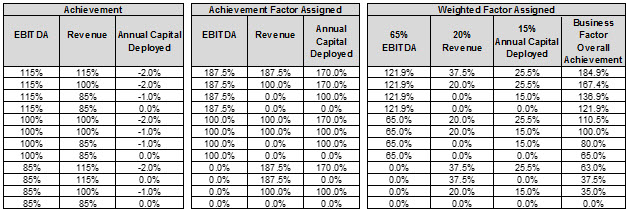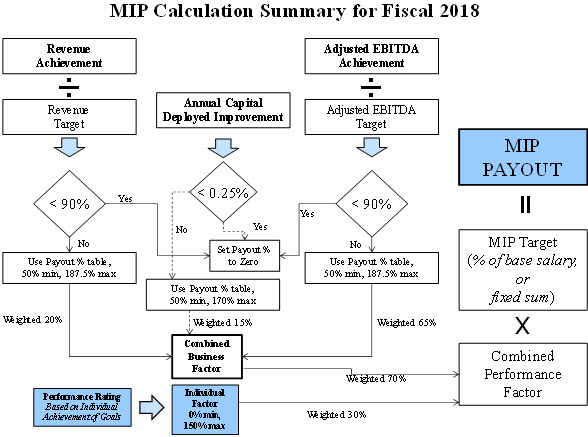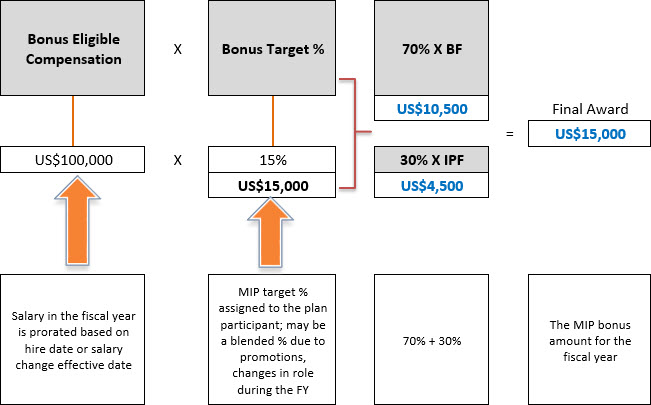Attached files
| file | filename |
|---|---|
| EX-32.2 - EXHIBIT 32.2 - Catalent, Inc. | catalent-2018930xex322.htm |
| EX-32.1 - EXHIBIT 32.1 - Catalent, Inc. | catalent-2018930xex321.htm |
| EX-31.2 - EXHIBIT 31.2 - Catalent, Inc. | catalent-2018930xex312.htm |
| EX-31.1 - EXHIBIT 31.1 - Catalent, Inc. | catalent-2018930xex311.htm |
| 10-Q - 10-Q - Catalent, Inc. | a10-qfy19xq1.htm |
Exhibit 10.50

Management Incentive Plan - FY2018
Summary Plan Description
Introduction
The Management Incentive Plan (MIP) is a variable annual cash incentive program that rewards performance against annual individual and business-based goals. Individual performance goals designed to support the broader business goals are established each year between eligible participants and their respective managers. The Compensation and Leadership Committee (the Committee) of the Board of Directors (the Board) of Catalent, Inc. (Catalent or the Company) selects the business-based goals for the MIP from among the corporate financial and strategic growth objectives approved each year by the Board.
Eligibility for the MIP is based on several criteria, including position in the organization and past performance. MIP participants are expected to play an important role in achieving the Company’s strategic goals and contributing to the growth of the Company and its people. Key features of the MIP, including funding and the determination and payment of individual awards, are described below.
Market-Based Program
Catalent believes that providing competitive market-based compensation is critical to attracting, engaging and retaining key talent and the critical skill sets and expertise necessary to make Catalent successful. With this in mind, Catalent’s incentive programs, including the MIP, are reviewed on an annual basis taking into account market compensation trends, annual financial goals, and changes in business strategies. Where appropriate, a review is performed and changes are generally agreed prior to the start of the fiscal year, although the Company reserves the right to make changes at any time.
MIP Alignment with Financial Goals
Catalent believes that the MIP acts best as an incentive when there is meaningful alignment between the business performance factors used to measure a participant’s achievement and the participant’s ability to enhance the performance of the overall organization through the participant’s position within the organization. Depending on a participant’s role, the business performance factors can be weighted among one, two, or three organizational levels (i.e., overall Catalent, the principal business unit to which the participant’s efforts are directed (if any), and the principal site and/or region to which the participant’s efforts are directed (if any)). In rare cases, the business performance factors may be weighted differently for participants who support multiple business units and/or sites. The chart below provides several examples of weightings for the business performance factors.
Exhibit 10.50
Business Performance Factors Weighting | |||
Position Category(1) | Overall Catalent | Business Unit | Site/ Region(3) |
ELT and Corporate | 100% | ||
BU Functional Leaders(2) | 50% | 50% | |
Site/Region-Based Leaders | 30% | 30% | 40% |
Site-Based Participants | 0% | 40% | 60% |
(1)As noted above, there may in rare cases be other weightings used for individual participants.
(2) | Includes positions that support business unit-wide initiatives (e.g., VPs of operations, quality, or finance for a BU). |
(3) | This weighting may take into account site/regional results, which may include the results of multiple BUs and sites. |
Business Performance Factors Combine for a Business Achievement Factor (BF)
As noted, the business performance factors measure achievement against a set of goals fixed each year by the Board and the Committee. For fiscal 2018, the Committee has elected to introduce a third business goal, “Annual Capital Deployed,” which will account for 15% of the business goals for our MIP, with the prior goals, Budget-Based Revenue and Adjusted “EBITDA” (earnings before interest, taxes, depreciation, and amortization), comprising 20% and 65%, respectively. Because the MIP measures achievement against budget, adjustments to Annual Capital Deployed, Revenue and EBITDA that are used in determining the budget will also apply when measuring performance, and results in foreign currencies will be converted to U.S. dollars at the currency exchange rates used to determine the budget.
The goal of the new metric, Annual Capital Deployed, is to improve Catalent’s working capital ratio, which in turn should result in an increase in cash flow. This improvement can come from, for example, improvements in collections and the management of payables. The target is to improve this ratio by one additional percentage point. For fiscal 2018, Catalent will calculate Annual Capital Deployed as the 12-month average of the Working Capital ratio using actual results at budget rates, where the ratio is (Working Capital)/(annualized computation of last-90-days revenue).
Achievement against each goal-Annual Capital Deployed, Revenue, and EBITDA-is measured separately, and an achievement factor is assigned based on the attainment against each goal. These achievement factors are then weighted-15% for Annual Capital Deployed, 20% for Revenue and 65% for EBITDA-to determine an overall business achievement factor (BF).
Set forth below are the charts used to convert the achievement against each goal to the achievement factor used to calculate the MIP.
Exhibit 10.50
Revenue and EBITDA Payout Scale
% of Target Achieved | Achievement Factor Assigned | Comment |
< 90% | Zero | Any payout at Committee discretion |
90% | 50.0% | Threshold performance @ 50% |
91% | 55.0% | |
92% | 60.0% | |
93% | 65.0% | |
94% | 70.0% | |
95% | 75.0% | |
96% | 80.0% | |
97% | 85.0% | |
98% | 90.0% | |
99% | 95.0% | |
100% | 100.0% | Target |
101% | 105.0% | |
102% | 110.0% | |
103% | 115.0% | |
104% | 120.0% | |
105% | 125.0% | |
106% | 132.5% | |
107% | 140.0% | |
108% | 147.5% | |
109% | 155.0% | |
110% | 162.5% | |
111% | 167.5% | |
112% | 172.5% | |
113% | 177.5% | |
114% | 182.5% | |
115% | 187.5% | Maximum performance @ 187.5% |
>115% | 187.5% | |
As seen in the chart, 100% achievement converts to a 100% achievement factor, and the achievement factor increases for improved performance against the targets and decreases if performance does not meet the budget target. The minimum achievement factor is 90%-below that, the assigned achievement factor is 0%. Similarly, the maximum achievement factor is 115%-above that, the assigned achievement factor remains the same. The Committee remains free, in its sole discretion, to make MIP awards even if achievement does not reach 90%.
Exhibit 10.50
Annual Capital Deployed Scale
Improvement in Annual Capital Deployed | Target Payout % | Comment |
-2.00% | 170% | Maximum |
-1.75% | 145% | |
-1.50% | 125% | |
-1.25% | 110% | |
-1.00% | 100% | Target |
-0.75% | 90% | |
-0.50% | 75% | |
-0.25% | 50% | Minimum |
As seen in the chart, reducing our Annual Capital Deployed by one full percentage point converts to a 100% achievement factor, and the achievement factor increases for improved performance against the 1.0% target and decreases if performance does not meet the 1.0% target. The minimum achievement factor is -0.25%--below that, the assigned achievement factor is 0%. Similarly, the maximum achievement factor is -2.0%--above that, the assigned achievement factor remains the same. The Committee remains free, in its sole discretion, to make MIP awards even if achievement does not reach -0.25%.
Set forth below is a chart showing, at multiple example levels of achievement, how the three separate business performance factors-Annual Capital Deployed, Revenue, and EBITDA-can come together to give participants a singled combined BF.

Note: | For fiscal 2018, the Committee has set the revenue and EBITDA performance thresholds at 90% of target and the Annual Capital Deployed at ‑0.25%. Funding for the MIP is dependent on achievement of at least the threshold level for these three performance metrics. If these hurdles are not met, MIP funding can only occur at the discretion of the Committee. |
Exhibit 10.50
Individual Performance Factor (IPF)
Each year, MIP participants, in collaboration with their managers, establish appropriate individual performance goals based on the individual’s role. These goals are to be aligned with the business performance goals established for Catalent overall. At fiscal year-end, managers determine each participant’s individual performance factor (IPF) based on the participant’s overall performance for the year, including achievement of the participant’s individual performance goals. In general, the IPF ranges from 0 to 150%.
For fiscal 2018, MIP participants who receive a performance rating of “Did Not Meet Expectations” will receive a zero IPF and will not be eligible for payout under the MIP regardless of the BF achievement.
The Business and Individual Performance Factors Are Combined to Determine the MIP Award
At the beginning of each fiscal year, a target MIP payout is set for each participant, usually expressed as a percentage of base salary. The amount actually paid to the participant following the end of the fiscal year is dependent on both the participant’s combined business achievement percentage (a non-discretionary fixed amount) and the individual performance factor assigned to the participant (based on manager’s discretion). For fiscal 2018, the combined BF is weighted 70%, and the IPF is weighted 30%, in order to obtain an overall combined performance factor, which is expressed as a percentage and then applied against the target. Because the BF can range from 0% to 187.5% for Revenue and EBITDA and from 0% to 170% for Annual Capital Deployed, and the IPF can range from 0% to 150%, the total MIP payout can range from 0% to 174.41% of the target payout amount.
Exhibit 10.50
MIP Calculation Summary for Fiscal 2018
Set forth below is a graphical summary of the MIP calculation process. For participants with multiple business factors (overall, BU, and site/region), the business factor calculation is performed separately for each segment, then combined as a weighted average, in order to determine an overall combined BF.

Exhibit 10.50
Below is an example of a MIP calculation for illustrative purposes:
In this example, we assume that all relevant business metrics perform at target. We also assume that the participant has a base salary of $100,000 and a MIP target of 15%, and that the participant ends the fiscal year with an individual performance factor of 100%.

Performance Updates During the Fiscal Year
The MIP design is open and transparent, reflecting Catalent’s confidence that Company leaders can deliver on its challenging but achievable goals.
Throughout the fiscal year, participants should review their progress against their personal goals with their managers. The senior management team will also provide updates on Catalent’s progress against its business goals. These individual and team updates will help participants to track their progress toward annual MIP funding and payout.
Exhibit 10.50
Effect of Employment Status Changes on Eligibility (Subject to Local Laws)
Your eligibility to receive a MIP award is affected by your employment status at payout. Listed below are payout provisions pertaining to different termination scenarios:
Event | Occurring prior to April 1, 2018 | Occurring between April 1, 2018 and MIP payment (scheduled for Sept. 2018) |
Voluntary termination (including resignation and job abandonment) | Not eligible for payout | |
Involuntary termination for cause* or for other than reduction-in-force/restructure/divestiture | Not eligible for payout | |
Involuntary termination due to reduction-in-force/restructure/divestiture | Not eligible for payout | Employees with continuous MIP-eligible service through the date of termination, where at least 90 days of that service occurred in fiscal 2018, will be eligible for payout at the normal payout date based on actual company/BU/site results (pro-rated for the portion of the year in service) and IPF as determined by the employees’ manager (similarly pro-rated) |
Death | Employees with continuous MIP-eligible service through the date of death, where at least 90 days of that service occurred in fiscal 2018, will be eligible for payout at the normal payout date based on actual company/BU/site results (pro-rated for the portion of the year in service) and IPF as determined by the employees’ manager (similarly pro-rated) | |
Retirement | Not eligible for payout | Employees with at least 90 days of MIP-eligible service in fiscal 2018 will be eligible for payout at the normal payout date based on actual company/BU/site results (pro-rated for the portion of the year in service) and IPF as determined by the employees’ manager (similarly pro-rated) |
Certain leaves of absence (LOA) may affect eligibility. Applicable LOA policies should be consulted on a regional basis. | ||
*Management reserves the right to determine in its sole discretion whether an individual termination of a MIP participant is for “cause.”
Exhibit 10.50
Eligibility Guidelines for New Hires and Newly Eligible Employees
If an employee’s start date or entry into a MIP-eligible position during the fiscal year is between July 1 and March 31 of a fiscal year, then the MIP target amount for that employee will be prorated to reflect the portion of that fiscal year during which the employee was eligible. Any employee with a start date or entry into a MIP-eligible position during the final quarter of a fiscal year (April 1 through June 30) will not be eligible for participation in the MIP for that fiscal year.
Timetable for Bonus Determination and Payment
After the close of the fiscal year, BF determinations will be made and overall MIP funding will be calculated.
At the appropriate time during the Catalent annual performance management cycle, year-end performance reviews will be completed and managers will determine and assign MIP-eligible participants an applicable IPF value based on assessments of individual performance against goals.
Typically, within 90 days of the end of the fiscal year (generally in September), individual MIP awards will be communicated.
Important Limitations on this Summary Plan Description
Please note that this document is only a summary of the Catalent MIP program. Participation in the MIP in any year is not a guarantee of participation in any future year. The application of the MIP to any given individual may vary depending on various circumstances, including the terms of any applicable employment contract, applicable regional laws governing employment, benefits, or payments under benefit plans applicable to only a subset of employees, and the terms of any applicable collective bargaining or employment agreement. Furthermore, the Company reserves the right to modify or cancel the MIP at any time, with or without notice to employees, to the fullest extent permitted by applicable law. In addition, separation from Catalent employment may affect a participant’s ability to participate in the MIP or the amount of the participant’s benefits in ways that are not fully described in this summary plan description. Employees with questions concerning eligibility for the MIP or the terms and conditions of the plan may contact their Catalent Human Resources representatives.
